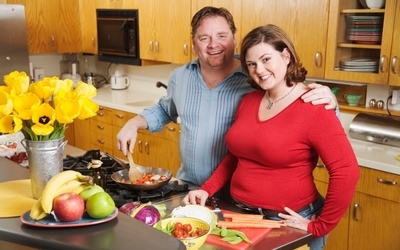Bigger Kitchen, Bigger Belly: Is Your Kitchen Killing You?
Your kitchen may be slowly killing you, but not in the way you think. While you may predict this article is about to warn you about the wellness dangers of radon or gas links, your wellbeing is actually at risk from kindness and proximity.
According to Neil Izenberg, founder of KidsHealth.org and a paediatrician at Nemours/Alfred I. duPont Hospital for Children, ‘When my 1840 Philadelphia row house was built for its seafaring owners, the kitchen was in the basement — like every other home on the block. If the family wanted a hot meal, someone had to tramp downstairs and stoke up the fire. Fire and smoke inhalation were chief among the many health hazards the 19th-century kitchen presented. In an era without refrigeration, food poisoning was a constant danger. Home-preserved foods filled in dietary gaps, but if stored improperly botulism became a real — and deadly — risk.’
Now, however, we’re less at risk to these hazards, so you don’t have to worry about kitchen wellness anymore, right? Izenberg notes, ‘Our kitchens, like our girths, have grown substantially, in terms of size and of function. They’ve become part of expansive entertainment complexes in our homes. A recent survey by the National Association of Home Builders reports that three out of four new-home buyers want their kitchen and family room to be a combined space. That makes sense. People like to hang out and socialise in their kitchens. Now great spaces are full of wonderful, convenient devices — with super-size refrigerators, stoves that could service a restaurant and large enough cabinets to store provisions for a small army. Even our dinner plates are bigger than they used to be. Comfy chairs, computer stations and a large-screen TV — virtual necessities — round out the picture.’
It’s a nice picture, but it perhaps covers up a dark underbelly; bigger kitchens mean bigger people. With all that storage for food, all those appliances and all those nice places to sit and eat together, there’s nothing but opportunity to sit and eat together. As a wellness writer, one tip I often hand out is to avoid “family-style dining” as this can cause you to keep dipping into a host of dishes on the table, without really realising how much you’re eating. However, if the dining room and the kitchen are one room, how can you help but keep going back for more – it’s all right there! Izenberg comments that his plans for his new kitchen will give him a similar problem of convenience: ‘Soon I’ll be able to amble (or, more likely, roll) a mere five feet from my kitchen counter stool to my couch to watch Chopped, Top Chef or Diners, Drive-Ins and Dives. The refrigerator, pantry and containers of food will remain alluringly in sight (and all beautifully lighted, I might add). I won’t even have to leave the room during a commercial. And why would I leave at all? The kitchen has Wi-Fi.’
He continues, ‘Many of the safety issues of yesterday’s kitchens are gone. No one in my family is likely to tumble into an open hearth. But new kitchens pose a more subtle danger to our health by doubling as a comfortable social, entertainment and eating hub. Retail marketers have long known that when tempting food is within close range of our eyes or nose, we tend to eat more of it. In our new kitchens, it’s just too darn easy to get to addictive snacks and calorie-rich drinks…There are, of course, many reasons for the nation’s obesity epidemic, with its staggering health implications. But surely modern home design plays an important and under-appreciated role.’


Comments are closed.